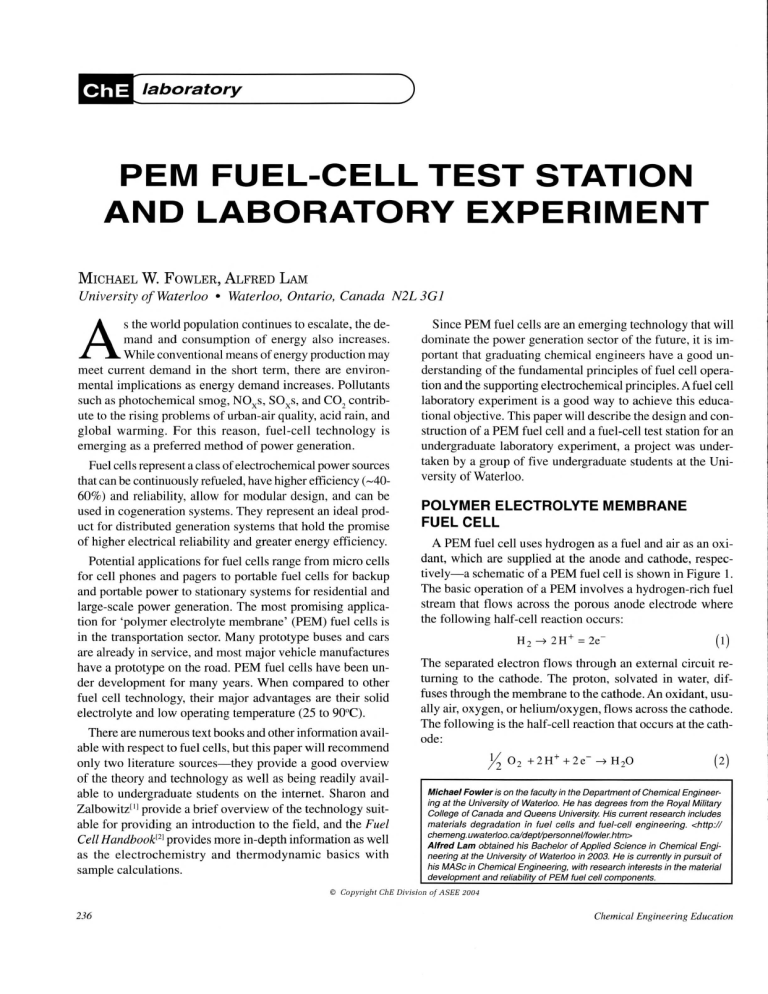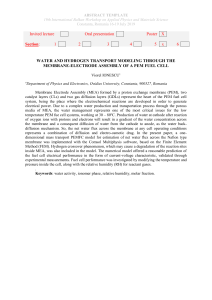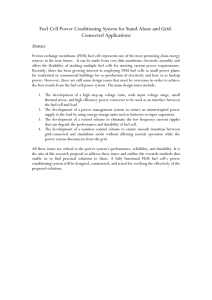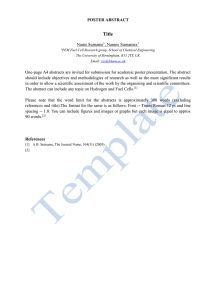
.tA_..ij111111§._1a_b_o_r._a_t_o_r.:.y_ _ _ _ _ _ _ _) PEM FUEL-CELL TEST STATION AND LABORATORY EXPERIMENT MICHAEL w. FOWLER, ALFRED LAM University of Waterloo • Waterloo, Ontario, Canada N2L 3G 1 s the world population continues to escalate, the demand and consumption of energy also increases. While conventional means of energy production may meet current demand in the short term, there are environmental implications as energy demand increases. Pollutants such as photochemical smog, NOxs, SOxs, and CO 2 contribute to the rising problems of urban-air quality, acid rain, and global warming. For this reason , fuel-cell technology is emerging as a preferred method of power generation. A Fuel cells represent a class of electrochemical power sources that can be continuously refueled, have higher efficiency (~4060%) and reliability, allow for modular design , and can be used in cogeneration systems. They represent an ideal product for distributed generation systems that hold the promise of higher electrical reliability and greater energy efficiency. Potential applications for fuel cells range from micro cells for cell phones and pagers to portable fuel cells for backup and portable power to stationary systems for residential and large-scale power generation. The most promising application for 'polymer electrolyte membrane' (PEM) fuel cells is in the transportation sector. Many prototype buses and cars are already in service, and most major vehicle manufactures have a prototype on the road. PEM fuel cells have been under development for many years. When compared to other fuel cell technology, their major advantages are their solid electrolyte and low operating temperature (25 to 90°C). There are numerous text books and other information available with respect to fuel cells, but this paper will recommend only two literature sources-they provide a good overview of the theory and technology as well as being readily available to undergraduate students on the internet. Sharon and Zalbowitz111 provide a brief overview of the technology suitable for providing an introduction to the field, and the Fuel Cell Handbook 121 provides more in-depth information as well as the electrochemistry and thermodynamic basics with sample calculations. Since PEM fuel cells are an emerging technology that will dominate the power generation sector of the future, it is important that graduating chemical engineers have a good understanding of the fundamental principles of fuel cell operation and the supporting electrochemical principles. A fuel cell laboratory experiment is a good way to achieve this educational objective. This paper will describe the design and construction of a PEM fuel cell and a fuel-cell test station for an undergraduate laboratory experiment, a project was undertaken by a group of five undergraduate students at the University of Waterloo. POLYMER ELECTROLYTE MEMBRANE FUEL CELL A PEM fuel cell uses hydrogen as a fuel and air as an oxidant, which are supplied at the anode and cathode, respectively-a schematic of a PEM fuel cell is shown in Figure 1. The basic operation of a PEM involves a hydrogen-rich fuel stream that flows across the porous anode electrode where the following half-cell reaction occurs: (1) The separated electron flows through an external circuit returning to the cathode. The proton, solvated in water, diffuses through the membrane to the cathode. An oxidant, usually air, oxygen, or helium/oxygen, flows across the cathode. The following is the half-cell reaction that occurs at the cathode: (2) Michael Fowler is on the faculty in the Department of Chemical Engineering at the University of Waterloo. He has degrees from the Royal Military College of Canada and Queens University. His current research includes materials degradation in fuel cells and fuel-cell engineering. <http:// chemeng.uwaterloo.caldeptlpersonnel/fowler.htm> Alfred Lam obtained his Bachelor of Applied Science in Chemical Engineering at the University of Waterloo in 2003. He is currently in pursuit of his MASc in Chemical Engineering, with research interests in the material development and reliability of PEM fuel cell components. © Copyright ChE Division of ASEE 2004 236 Chemical Engineering Education The proton and returning electron combine with oxygen to form water. The net reaction is (3) The membrane electrode assembly (MEA) consists of a polymer electrolyte membrane, electrodes, and a gas-diffusion layer. Within a fuel-cell stack, the MEA is compressed between two bipolar plates. Therefore, the key components of a PEM fuel cell are • • • • A polymer electrolyte membrane An electrode A gas diffusion layer (GDL) Bipolar plates In designing a PEM fuel cell, the objective was to select an appropriate "scale" for the active area so the students would be able to generate a reasonable current, could vary the various parameters, and could observe the operational variability. A further constraint was a very limited budget for the fuel cell and test station. Ultimately, the design group developed a test station for the operation of a PEM fuel cell with an active area of 50 cm 2 (a 100-cm2 cell was also designed and constructed by students). Note that a "stack" of a number of cells, or a larger ~et~. \ e 0 I = 0 0 0 Anode GDL ~ ®-+ L Mcmbrane~ -- C, (from air) e,o Catalyst Figure 1. Operational schematic of PEMFC. Current colleclur Gas dlfl'tlllon layer Guket Ead plate Bolt lloles Figure 2. PEMFC component schematicJ31 Summer 2004 Since PEM fuel cells operate at low temperatures, a catalyst is required to achieve sufficient reaction rates for hydrogen oxidation at the anode and oxygen reduction at the cathode. The gas-diffusion layer is composed of porous carbon paper or carbon cloth that is treated with polytetrafluoroethylene . The GDL ensures that reactant gases are distributed evenly and effectively over the catalyst layer, provides effective liquid water removal at the cathode, provides for uniform load distribution on the electrolyte, and provides for electrical cond uction between the graphite plates and the catalyst layer. PEM FUEL-CELL TEST STATION Membrao, Gnphlte Oow-dian• d lllock The polymer electrolyte membrane is the most critical component of a PEM fuel cell. It conducts hydrogen protons from the anode to the cathode and acts as an electrical insulator to ensure that electrons travel through an external circuit. In the test set-up, an integrated membrane electrode assembly (MEA) with a perfluorosulfonate ionomer was selected . The catalyst layer was composed of a carbon powder (Vulcan XC-72, Acetylene Black), precious metal (Pt, PtRu), and Nafion mixture . The gasket is composed of Teflon sheeting. It is positioned around the membrane electrode assembly to ensure complete sealing upon compression. The seal prevents reactant gases from escaping into the environment or crossing over from the anode to the cathode. Gas-flow channels are machined into the plates to provide an inlet and outlet point for reactant gases. The depth and width at which each channel is machined can affect gas distribution over the MEA and water removal at the cathode. The plates also serve as electrical conductors . Copper current collectors with ports for electrical connections are used. Aluminum end caps and bolts are used to form mechanical compression and connection of the fuel-cell components. This is essential for complete sealing and the reduction of contact resistances. e Heat e, cell , would also be interesting, but wou ld be cost prohibitive in capital and operating costs for most undergraduate labs . The PEM fuel cell design consists of the following major components: a polymer electrolyte membrane, a gas diffusion electrode, a gasket, graphite plates, current collectors, end caps, and bolts. A schematic is shown in Figure 2. In designing the test station, our objective was to all ow easy monitoring and manipulation of the appropriate variables so calculations associated with different electrochemical principals could be conducted. The station provides an environment in which a PEM fuel cell can operate. It will also enable the testing of future undergraduate design projects that involve the construction of a fuel cell. The test-station environment consists of the following systems: 237 gas-flow control, water manage ment, electrical, data acqui sition , and safety. A schematic of the test station is shown in Figure 3. The gas-flow system comprises two mass-flow meters and two mass-flow controllers. The role of these components is to monitor and regulate reactant gas flow, control systems pressure and to aid in fuel consumption calculations. The water-management system compri ses two hydrators, a heated water bath, and two knock-out drums. The role of the hydrators is to add moisture to the reactant gases prior to entering the PEM fuel cell because hydration of the membrane is critical to optimal performance. Double-pipe Nafion hydrators are used because of their transfer efficiency over a small surface area and volume. The role of the heated water bath is to control hydration levels and to heat and circulate water to the hydrators. The role of the knock-out drums is to condense the moisture in the exit streams as the water may damage the mass-flow controllers. The electrical system comprises a switch, a shunt, and a resistor. The switch is used to open the circuit, while the shunt allows accurate measurement of high current and the resistor enables the application of variable resistance. There is a current undergraduate project that involves designing a variable electrical load for the system. The data acquisition system enables fuel-cell performance data to be recorded . Lab View software is used for real-time monitoring and control of the following parameters: resistance, pressure, reactant gas flow, temperatures, power measurements, and reactant gas stoichiometric ratio. This software allows maximum fl exibility for future students to design experimental protocol s. Figure 4 is a screen shot of the Lab View virtual instrument. The safety system enables detection and removal of explosive reactant gases (i.e., hydrogen) from the test station. A hydrogen detector is installed to monitor any leakage that may occur during operation. An emergency stop button is available on the Lab View interface and upon activation, the three-way solenoid valve switches and purges the station with nitrogen. Exhaust gases that exit the fuel cell are routed into a fume hood. PEM FUEL-CELL LABORATORY EXPERIMENT Obiective The objective of the laboratory experiment was to examine fuel cell technology and its associated electrochemical properties, as well as to examine the effect of performance characteristics. 238 The PEM fuel-cell test station will be integrated into the experimental portion of a third-year chemical engineering course, "Inorganic Process Principles 2," and as a demonstration experiment in "Chemical Environmental Engineering Concepts 2." Used as a demonstration, students will be able to conduct basic mass balances, as well as humidification calculations, on the gas streams. In the process principles course, more advanced electrochemical concepts are covered, including polarization and efficiency. Operation of the fuel cell provides a practical application of polarization in an electrochemical cell. In addition, fourth-year students from chemical, mechanical, or electrical engineering disciplines can use the fuel cell and test station for related design projects. Basic Fuel-Cell Thermodynamics Fuel cells directly convert chemical energy into electricity and are thus not bound by the Carnot law as in combustion reactions. Heat engines cannot completely convert all the available heat energy into mechanical energy due to some of the heat being rejected . The reversible energy efficiency of the electrochemical cell can be found using ll rev = 6G = I -T 6H (4) 6S 6H The direct conversion of chemical energy of a fuel and oxidant into electrical energy can be described in terms of electrical current output and cell potential. A maximum cell potential, also known as the reversible cell potential, is achieved when a fuel cell is operated under a thermodynamically reversible condition. Thi s can be calculated using o 6G E =-nF (s) The effect of temperature changes on cell potential can be To Fume Hood Fuel Cell M ass flow Controlle rs Shunt H2 Figure 3. Schematic of fuel-cell test station . Chemical Engineering Education calculated by (!~ ) = - a:: \ = ~! (6) n~ ( P Typically for a PEM fuel cell , S, for hydrogen is l.l to 1.2, and S, for oxygen is 2. Fuel utilization is the inverse of the stoichiometric ratio ( to) The effect of pressure changes on cell potential can be calculated by (aE) oP I T =- (o6G) nF ~ 6V T (7) nF The Nemst equation for a hydrogen oxygen system is defined by As hydrogen and oxygen are consumed, the partial pressures of each decrease respectively. Thi s results in a decrease of overall potential, as stated by Eq. (6) . In order to reduce these losses, excess stoichiometric amounts of reactant gases are supplied. The excess also addresses water management issues. The stoichiometric ratio is SI - . N;n N;n N consumed Nin - (9) N out Electrode Kinetics In the practical application of fuel cells, the reversible cell potential can never be achieved due to irreversible activation , ohmic, and diffusion overpotenti als. The activation overpotential is the loss associated with the activation barrier th at the reactant species mu st overco me . The ohmic overpotential is the loss associated with the resistance of cell components. The increased mass transfer resistance of reactant gases through the electrode structure at high current densities causes diffusion overpotentials. Figure 5 is a typical polarization curve showing the effect of the losses on the reversible cell potential. Th e following relation s de scribe the activation overpotential: 1lac1 =a+ -2.3RT 1 . ( IZ) b_2.3 RT ( l 3 ) bl og 1.( II ) a = ~ og 10 cmF Ohmic overpotentials are described by 11 ohmic (14) = iRohm where R is the resistance (ohm). The concentration overpotential is described by ll conc =-RT en( I nF i -:- J ( 15) 'L Experimental Figure 4. Lab View screen shot of the fuel-cell test station virtual instrument. Theoretical EMF or Ideal Volta: 1.2 Power ------ \ ---- • R,1lon or Ac tl va tloa Polarlullon (Ruction Rite Lon) ~ 0.8 15 I . ~ ~ 0.6 ...~ •., / 0.2 Rr1lon of Coauntnllo n Pol1rlullo11 (M111 TnHporl Loll ) / 0 0.1 0.2 0.3 0.4 0.5 0.6 0.7 0.8 0.9 Current Density Amp cift Figure 5. Typical polarization curve and power curve. Summer 2004 The objective of this experiment is to examine the effect of performance characteristics, fuel-cell tec hnology, and the associated electrochemical losses. The associated class covers electrochemical concepts such as activation overpotential, ohmic losses or overpotential , and co ncentration overpotential, with the objective of reinforcing these concepts with the student while providing an introduction to the technology. Thi s lab also provides a basic engineering design exercise as well as reviewing physical chemi stry calculations. The undergraduate experiment involves development of a polarization curve (voltage vs . current density) at various temperatures (kept low so as to not stress the cell , 20-70°C), various cathode and anode pressures (once again, kept low to avoid stressing the membrane, 5-15 psig). The apparatus also allows the students to explore operation at various stoichiometric ratios for hydrogen and oxygen. Changes in performance agai nst a baseline polarization curve are examined and analyzed. Actual student data of the effect of variations in temperature and pressure can be seen in Figures 6 and 7, respectively. With advancement in technology and as "com239 mercial" single cells and membranes become more widely available, better performance of the cell can be expected, and students can discuss how their performance compares to published results . Post-experimental tasks include: examination of the overpotential regions that the polarization points are within ; determination of the maximum power output; calculation of voltage and overall efficiencies; stack sizi ng for a 75-kW and 42-volt system; and hydrogen storage tank sizing for a vehicle running at peak power (75 kW) for two hours. Students are then asked to take the collected data and design a cell for a 1-kW application (e.g ., simple calculation of the number of cells, stacks, and active area of the cell). These last two calculations provide simple "engineering design tasks" that are a critical component to educational programs. CONCLUSIONS The addition of a PEM fuel-cell test station and laboratory experiment into an undergraduate chemical engineering curriculum can have the following benefits: • Students are exposed to significant new technologies that are being developed and produced. By providing laboratory experiments that are relevant to operational technology, we are able to teach pertinent concepts and skills. Students also use software and research tools that are widely used in industry. • Students are introduced to the emerging hydrogen economy and the use of hydrogen as an energy vector. U~ - - - - - - - - - - - -------, • Students gain a working knowledge of PEM fuel- cell operation, optimization, and equipment sizing. • Students gain a better understanding of electrochemical properties and the effect of performance characteristics on a fuel cell. • Students are able to examine the materials and fun ctionality of PEM fuel- cell components. • Students gain an understanding of the various systems that enable a fuel cell to operate. • The test station can fa cilitate future projects relating to PEM fuel cells at both the graduate and undergraduate levels. • Co-operative education and graduate employment are assisted by providing students with education and experience in a growing industry secto,: Should the reader wish to construct a similar lab, more detailed information and specifications can be obtained from the authors. NOTATION ~G ~H ~S ~V a E' F iL i0 n change in Gibbs free energy change in enthalpy change in entropy change in volume electron transfer coefficient reversible cell potential Faradays Constant (96,487 Coulomb/mo) electron) actual current density (A) limiting current density exchange current density mols of electrons/mo( of fuel Nin molar flow rate of reactants supplied N out molar flow rate of reactants exiting. hydrogen partial pressure water partial pressure oxygen partial pressure universal gas constant resistance (ohm) temperature (K) PH2 PH 20 po2 R R Ohm - - ~- - ~ - - ~ - ~ - - ~ - ~ - - ~ , T 0 .35 Carrut Dea1l ty (A mp eife ACKNOWLEDGMENTS Figure 6. Effect of pressure on performance (student-collected data). 8 1 0.9 0.8 ';; 0.7 ~ 0.6 ~ 0.5 ~ 0.4 > 0.3 0.2 0.1 7 6 t: 5 .. 4 3 2 REFERENCES o ~- - - ~ - - - ~ - - - ~ ~ - - ~ 0 0 0.1 0.2 0.3 0.4 Current Density (Amp cift) Figure 7. Effect of temperature on performance (student-collected data). 240 ~ ...~ Funding for construction of the PEM fuel-cell test station was provided in part by the Waterloo Engineering Endowment Fund and the Department of Chemical Engineering at the University of Waterloo. We also acknowledge the remaining members of the group that designed and built the station: Erik Wilhelm , Rob McArthur, Dave Chen, Dara Jahani , Jon Shui, and Sumit Kundu . I. Sharon, T., and M. Zalbowitz, Fuel Cells: Green Power, Los Alamos National Laboratory ( 1999) <http://www.osat. umich.edu/fuelcellsGreenPower. pdf> 2. EG&G Services Parsons, Inc., Science Applications International Corporation, Fuel Cell Handbook, 5th ed., U.S. Department of Energy (2000) <http://www.fu elcells.org/fchandbook/pdf> 0 Chemical Engineering Education





